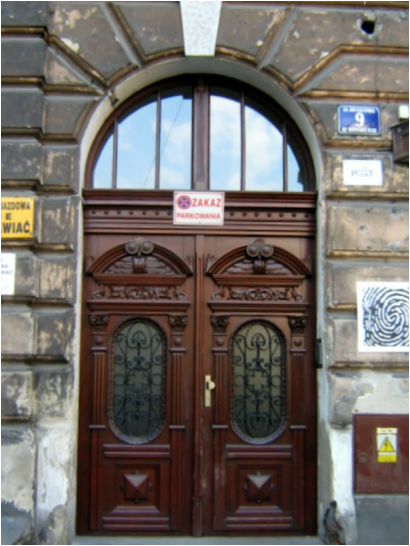 Front doors of the Dinter family residence at Brzozowa 9, Krakow, Poland. (Photograph taken by Rivka Schiller, September 2014.) Front doors of the Dinter family residence at Brzozowa 9, Krakow, Poland. (Photograph taken by Rivka Schiller, September 2014.) Two years ago I met several descendants of Rabbi Simcha Dinter (1867-1929), an active member of the Belzer Hasidic dynasty and a right-hand man to the then third and fourth Belzer Rebbes, respectively, Rabbis Yissachar Dov Rokeach (1851-1926) and his son, Aharon Rokeach (1880-1957). When the family learned that I was traveling to Poland last fall, they asked me if I would take photographs of the Dinter family property in Krakow, located at 9 Brzozowa Street in the once heavily Jewish neighborhood of Kazimierz. When I reached 9 Brzozowa Street, I expected to find a small house. However, much to my pleasant surprise, I found myself gazing up at an impressive stone building, several stories high. Fortunately, one of the tenants of this apartment building was leaving and allowed me to enter and take photographs of the building’s interior. Unlike what I witnessed in Warsaw, my grandmother’s city of origin, in which the vast majority of buildings did not survive the bombings of World War II, this building is quite intact. Moreover, it has been extremely well maintained. It still bears the original, huge, and intricately hand-carved wooden front doors. From the interior staircase landing, I peeked out the window overlooking the sizable backyard, where, according to Dinter family members, two wooden frame houses formerly stood. I began to picture the celebration of the Jewish holiday of Sukkot, the large, extended Dinter family, along with the building’s other Jewish tenants seated in the Sukkah, eating their meals, and singing festive holiday songs. 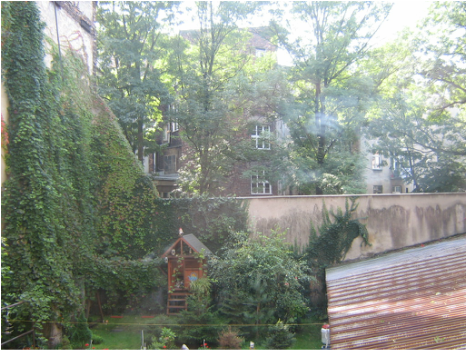 View of the Dinter family’s expansive former backyard from the building’s interior. (Photograph taken by Rivka Schiller, September 2014.) View of the Dinter family’s expansive former backyard from the building’s interior. (Photograph taken by Rivka Schiller, September 2014.) After I returned to New York, the Dinter family asked me to assist them with additional genealogical research about their family, particularly about their progenitor, Rabbi Simcha. Following is the story of the Dinter family and the biography of Rabbi Simcha, as it was related to me by one of his grandsons. Rabbi Simcha was one of the Gabbais (or Gabbaim; trusted aides) to the aforementioned Belzer Rebbes. Upon his marriage to Bina Dreier, Rabbi Simcha moved from the town of Belz to the city of Krakow, the hometown of his new bride and the Dreier family’s site of residence.  View of Brzozowa 9, Krakow, Poland, from a distance. (Photograph taken by Rivka Schiller, September 2014.) View of Brzozowa 9, Krakow, Poland, from a distance. (Photograph taken by Rivka Schiller, September 2014.) In Krakow, Rabbi Simcha purchased a large apartment building in the historically centrally-located neighborhood of Kazimierz, the city’s predominantly Jewish quarter. The Dinters had eight children and owned a family business that made medical uniforms. Rabbi Simcha was a major financial supporter of the Belzer Hasidim. Not only did he give generous donations from his own funds, but he also raised money both in Galicia and in America. Beginning in 1908, Rabbi Simcha made more than a dozen trips between Krakow and America, speaking to Belzer Hasidim about the importance of sending money to the Belzer community in Europe. On his 1914 visit to America, Rabbi Simcha arrived with his wife and five of his children. When shortly thereafter, World War I broke out, the family spent the remainder of the war and beyond on the Lower East Side of Manhattan. Rabbi Simcha started a business producing wigs for dolls. In those day, dolls were made of porcelain and wigs were glued-on. Before the war, most of the toys and dolls sold in America were manufactured in Germany, and the war curtailed this production. As this created a newly-found opportunity, some Jews from Galicia (then part of the Austro-Hungarian Empire) went into this business. 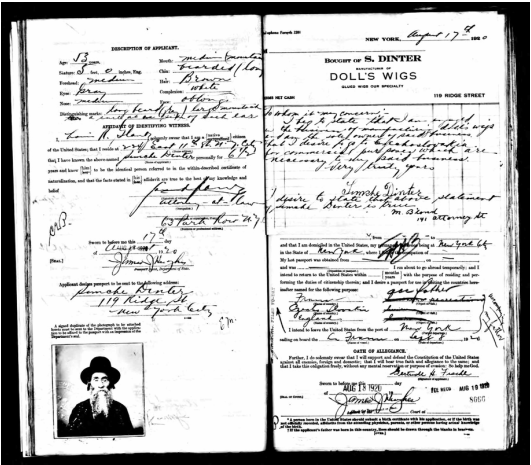 Simcha Dinter’s American passport application (including a photograph of the applicant), c. 1920. (Thanks to Gideon Goldstein for providing this image.) Simcha Dinter’s American passport application (including a photograph of the applicant), c. 1920. (Thanks to Gideon Goldstein for providing this image.) When the war ended in late 1918, the Belzer community was in dire need of financial assistance. Rabbi Simcha expended his time and energy in raising money for the Belzer community in Europe. Rabbi Simcha's letters-to-the-editor were published in Yiddish newspapers and advertised that he would be speaking on the Lower East Side as part of this fundraising campaign. In 1920, Rabbi Simcha, who had become an American citizen, applied for a U. S. passport to return to Europe. Interestingly, his passport photo showed him appearing as a typical Hasidic Rabbi. Perhaps today it is not unusual to see somebody who looked like Rabbi Simcha on the streets of New York City, but in 1920, it was quite unusual. The first thing almost all religious male Jews did upon arrival in America was to shave or trim their beards, cut off their sidelocks (Peyes), get rid of their black hat, and to dress like average American males of that day. But such was not the case with Rabbi Simcha. His passport application describes him as having a “long beard (grey), large moustach[e], [and] a curl at [the] side of each ear.” In his passport photo, Rabbi Simcha is wearing his rabbinical black hat – clearly, he refused to remove it for this photo. 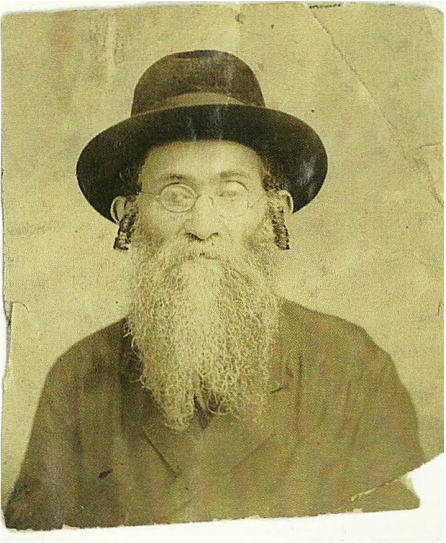 Simcha Dinter posing in traditional Hasidic garb for his American passport application, c. 1920. (Thanks to Dinter family members for providing this photograph.) Simcha Dinter posing in traditional Hasidic garb for his American passport application, c. 1920. (Thanks to Dinter family members for providing this photograph.) In 1923, Rabbi Simcha can be found in a photograph with the Belzer Rebbe and his aides, which was taken in Marienbad, Czechoslovakia (today, the Czech Republic), a well-known resort where many Hasidim vacationed prior to World War II. During this visit to Marienbad, Rabbi Simcha and his wife Bina were photographed strolling in the town square. Rabbi Simcha's four daughters and one son remained in New York, while he and his wife returned to Krakow. Afterward, Rabbi Simcha made yearly trips to New York, raising funds for the Belzer community. Rabbi Simcha died in 1929; his wife Bina, in 1936. They are both buried in the new Jewish cemetery in Krakow on Miodowa Street. Sadly, the Dinter family met the same fate as most of Poland’s Jews. The three children of Rabbi Simcha who still resided in Poland, not being American citizens, found themselves trapped there when World War II broke out on September 1, 1939. In the summer of 1940, the Germans ordered the majority of Krakow’s Jews to relocate to other ghettos. The Dinter family chose to go to the Bochnia ghetto, where some relatives owned property. Along with their children and spouses, Rabbi Simcha’s three children managed to survive until the first Aktion [i.e., the assembly and deportation of Jews to concentration or death camps] of the Bochnia ghetto in the summer of 1942. Most of the Dinter family perished during this Aktion, others during the Aktion in the summer of 1943. During these Aktions [Yiddish: Aktsyes], those who were not killed in Bochnia were deported to death camps, where the overwhelming majority were murdered upon arrival. At the war’s end, of the entire Dinter family that had been caught up in Hitler’s murderous web, only one of Rabbi Simcha’s grandsons had managed to survive. Fortunately, research discovered a rare, well-preserved document issued by the Krakow Jewish community on August 9, 1940, just prior to the Dinter family’s relocation to the Bochnia ghetto. This document, which bears a distinct photo, is the registration form of Abraham Dinter, a teenage grandson of Rabbi Simcha. Tragically, Abraham Dinter would be murdered only two years later, in August of 1942, in the Belzec death camp. 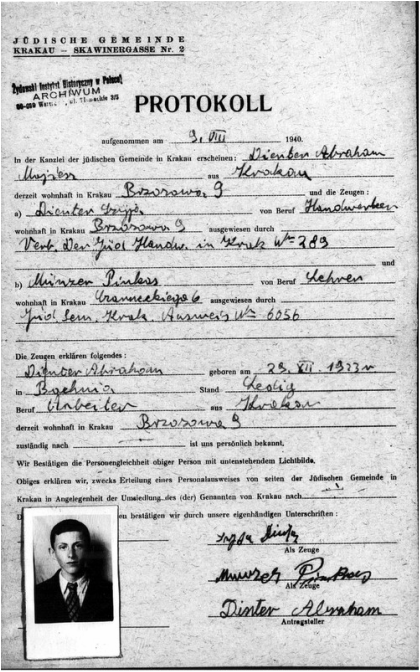 Abraham Dinter (b. December 29, 1923 - d. 1942), one of the many Dinter family members who perished in the Holocaust. Note the address of residence indicated on this form, issued by the Jewish community of Krakow and dated August 9, 1940: Brzozowa 9, Krakau (Krakow). (Thanks to the Jewish Historical Institute in Warsaw, Poland for uncovering this document, and to the Dinter family, for allowing me the use of it here.) Recently, an article was published in an Ultra-Orthodox journal printed in Israel, detailing the relationship between Rabbi Simcha and the Belzer Rebbe. Dinter family members asked me to translate this article. The article, which was written in Hebrew, contained undated newspaper clippings pertaining to Rabbi Simcha and his fundraising on behalf of the Belzer Hasidim. The Belzer Rebbe is often referred to as the “Tzaddik” [i.e., a frequently used title for a Hasidic leader or rabbi]. I was glad to assist the family with this translation as well as to visit their former homestead at 9 Brzozowa Street in Krakow. In some sense, this is both where the saga surrounding the Dinter family begins as well as ends. At this late date (2016), there are no known Dinter family members residing in Krakow or in Poland, for that matter. The family’s scattered remnants now reside in Israel, the United States, and in Canada, where they have sowed new roots and sprouted new branches. Following are some of the aforementioned newspaper clippings, originally in Yiddish and Hebrew, along with my accompanying translations: 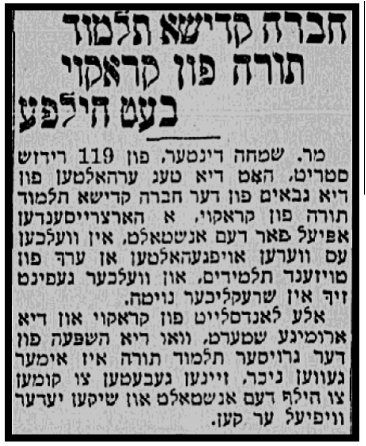 Der Tog-Morgen Zshurnal/The Day-Jewish Journal [?] Chevra Kadisha Talmud Torah of Krakow Requests Help [Author not indicated, undated; Yiddish] Mr. Simcha Dinter of 119 Ridge Street [i.e., the Lower East Side, Manhattan, New York] received a heart-wrenching appeal from the Gabbais of the Chevra Kadisha Talmud Torah of Krakow, for the institute, which maintains approximately one thousand students, and which finds itself in terrible need. All the kinsmen from Krakow and the surrounding towns in which the influence of the great Talmud Torah was always well-recognized, are asked to come help the institute, and everyone should send as much [money] as he can. 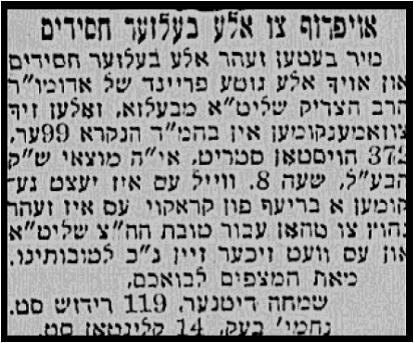 Der Tog-Morgen Zshurnal/The Day-Jewish Journal [?] Announcement to All the Belzer Hasidim [Author not indicated, undated; Yiddish] We greatly implore all the Belzer Hasidim, as well as all the good friends of Our Master, Our Teacher, and Our Rabbi – may he live for many good days, amen – from Belz, that they gather together at the religious study house known as the “99er,” 372 Houston Street [i.e., the Lower East Side of Manhattan], if God wills it, this coming Saturday night at 8 o’clock. For a letter just arrived from Krakow; it is very urgent to do good on behalf of the Rabbi, the Tzaddik – may he live for many good days, amen – and it will certainly be for our own good, as well. From those who are anticipating your arrival, Simcha Dinter, 119 Ridge Street Nechemia Beck, 14 Clinton Street [i.e., the Lower East Side of Manhattan].
20 Comments
3/14/2016 10:58:32 am
My grandmother was Sarah Altkorn born in Grodeck, Poland. My grandfather, Riven Gruenspan was was born in Tarnpol, Poland. They were killed in the Holocaust.
Reply
3/17/2016 02:58:28 pm
Hi Ronald,
Reply
3/14/2016 05:55:23 pm
Hi, Rivka. This is a fascinating story, beautifully told -- as always.
Reply
Nancy Thaler
3/14/2016 08:28:55 pm
Hi Rivka,
Reply
3/15/2016 03:28:59 pm
Dear Nancy,
Reply
Arthur (Avrom) Miller
3/15/2016 06:17:45 am
Rivka,
Reply
3/15/2016 03:47:40 pm
Avrom,
Reply
3/15/2016 03:20:09 pm
Hi, Lauren.
Reply
Peter
3/16/2016 01:22:37 pm
Just amazing that Rabbi Simcha Dinter kept his black hat on for his American passport photo. In 1920, that took a great deal of courage. You did fantastic research in tracing the family history from Belz to Krakow to America and back to Krakow along with the accompanying photographs. I am particularly impressed that you were able to uncover Abraham Dinter's documentation with his photo. Keep up the good work.
Reply
3/17/2016 03:13:52 pm
Dear Peter,
Reply
ND Weiss
3/20/2016 01:28:03 pm
Dear Rivka,
Reply
Adrienne Dinter
3/21/2016 09:31:35 am
Rivka, Thank you sooooo much for this awesome article about the Dinter's. We loved it!!!!! You are amazing!!!!! My whole family loved it!!!! We appreciate it sooooo much. Be well, and thank you again. Adrienne.
Reply
3/21/2016 09:55:04 am
Adrienne,
Reply
3/21/2016 09:51:14 am
Dear N. Dina,
Reply
Jay Ipson
3/21/2016 10:43:31 am
Brings back memories of pr-WWII Europe
Reply
3/21/2016 11:01:42 am
Thank you, Jay, for your vote of authenticity -- spoken as a true pre-WWII native of (Eastern) Europe! I am sure that you and some of my other readers can find material here to which to relate.
Reply
Xavier Vanvaerenbergh
6/6/2016 12:22:43 am
Hello,
Reply
6/7/2016 07:21:40 am
Dear Xavier,
Reply
Rosalie Halstuch(Glait)-Kupfer
1/15/2017 08:04:16 am
Enjoyed reading your article.I am a cousin of Ruthie Glait which also makes a Chmelnicker landsman(on my mother's) side.
Reply
1/15/2017 08:39:15 am
Hi Rosalie,
Reply
Your comment will be posted after it is approved.
Leave a Reply. |
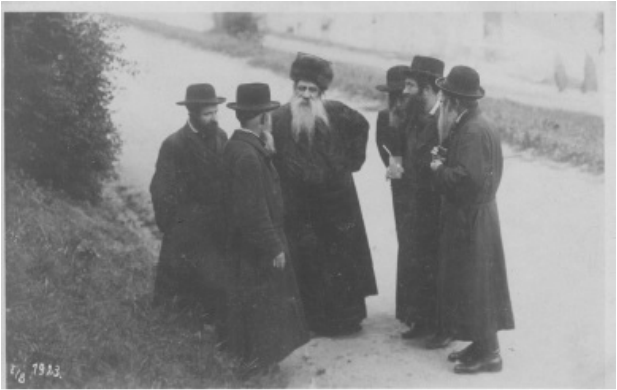

 RSS Feed
RSS Feed